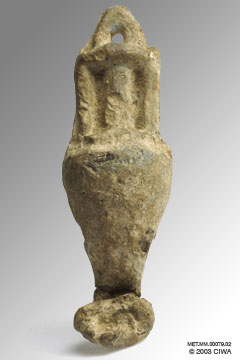Amphora-shaped lead weight, 300-50 BC

Links to other views:if scripting is off, click the ⇒ instead.Links to others of type Measuring of weightBronze weight or plumb bob, Rome, 100-300 ADHermes bronze counterpoise, c. 420 BC Lead weight with trade mark, 300-30 BC |
This lead weight in the shape of an amphora weighs about half a Greek mina (1 mina = 431 g.). Probably Etruscan or Greco-Roman, 300-50 BC. Mina “A historic unit of weight, originating in Babylonia and used throughout the eastern Mediterranean. The mina is roughly comparable to the pound, but over the centuries it varied quite a bit. In Babylonian times it was a large unit, roughly 2 pounds, almost as much as a kilogram. The Hebrew mina, frequently mentioned in the Bible, is estimated at 499 grams (1.10 pounds). The Greek mina was equal to 431 grams (0.95 pound). In Biblical times the mina was equal to 60 shekels, and there were 50 minas in a talent” (Rowlett and University of North Carolina, Chapel Hill 2004: http://www.unc.edu/~rowlett/units/dictM.html). |